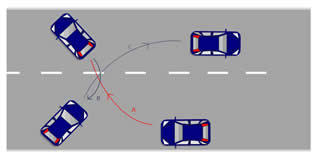Driving instructor vacancies in Basildon
- Jul 08, 2019
A Turn in the Road is more fondly known as a 'three point turn' by more experienced drivers.
However the amount of turns required depends on many factors and therefore it is a manoeuvre that allows us to change direction in as few turns as possible.
The manoeuvre is useful for turning when a side road can't be found or the road you are on is unsuitable.
Before the turn is attempted a place that is legal, safe and convenient has to be chosen. Here you will need to consider simple factors that meet the criteria.
The secret of the manoeuvre is to keep the moving very slowly whilst steering briskly. Close control of the clutch is essential. If you do not have sufficient ability to control the clutch due to lack of practice or guidance then it would be advisable to seek further help first.
Coordination of controls
Clutch control means using the clutch to control the cars speed by lifting or depressing the clutch pedal enough to quicken or slow as required. When the biting point is found, the car should begin to move and when the clutch is pressed in (typically the width of a £1 coin) the car will slow.
It is important to note that this procedure will only work correctly when the car is travelling at very slow speed (typically walking speed) and should not be used during normal driving.
The coordination of pedals will depend on the road gradient or camber. It is important to coordinate the clutch with either brake or accelerator. Avoid being tempted to use only the clutch as this might result in the engine stalling.
Observation
All round observation is essential throughout the manoeuvre. Before making any move, make sure you check all round, especially your blind spots.
When reversing, look in the direction of travel. You might find it more helpful to turn in the seat so that you have a clearer view through the rear window.
The manoeuvre

Stop on the left in a suitable place avoiding traffic furniture such as lamp posts or trees, close to the kerb but not touching it.
Assuming that you have considered that the chosen place is legal, safe and convenient, select first gear and prepare to move.
Slowly move forward in first gear, turning your steering wheel briskly to right full lock (line A). Only turn when the car is moving otherwise you may end up dry steering which could result in damaging the steering mechanism and tyres.
Just before you reach the opposite kerb, still moving slowly, begin to steer briskly to the left. Your wheels will then be ready to reverse in the correct direction as well as being able to move slightly further across the road.
As you near the kerb, declutch and use the footbrake to stop. Although you want to position close to the kerb, try to avoid over hanging the kerb or indeed touching it as this may damage your car or intrude upon the pedestrian's path. At this point, you might find it useful to check for the kerb under your right door mirror.
It may be necessary to use the parking brake to hold the vehicle still especially if there is a slope or camber in the road. It should be noted that is not always required.
Having selected reverse gear begin you all round observation beginning with your right blind spot check finishing over your left shoulder, through the rear window. Take enough care to actually see what is really there and act upon what is seen.
Continue to look through the rear window as you begin to slowly start reversing (line B). This will help you to see where you are travelling and any road users that might be moving in the direction that you are travelling. Continue turning the steering wheel to the left aiming to get the wheels fully turned (full lock).Careful coordination of the pedals will allow more time to achieve this.
As the car nears the kerb, turn to look over your right shoulder which will allow you to view the kerb. If you steered sufficiently the car should be at such an angle that you will notice the kerb more easily between the roof pillar and head restraint. Turn the steering wheel briskly to the right to help the forward movement.
Press the clutch pedal down and use the footbrake to stop. Avoid hitting the kerb. It may be necessary to use the parking brake to hold the vehicle still especially if there is a slope or camber in the road. It should be noted that is not always required.
To drive forward again, check the road is clear and drive forward when it's safe to do so (line C). In normal driving, check your mirrors having completed the manoeuvre to make sure it's safe to proceed.
If you have not completed the turn then don't panic, just be prepared to follow the above steps as necessary.
If you notice other road users approaching whilst under taking the manoeuvre act clearly upon what you have seen. If other road users are still moving at speed or too near your car, wait otherwise move if safe. Avoid waving others to move as this might not be safe.